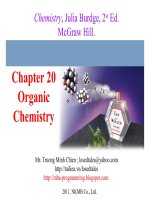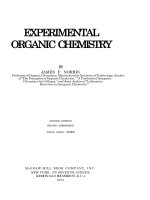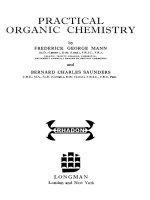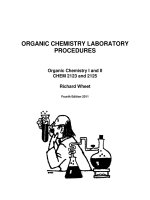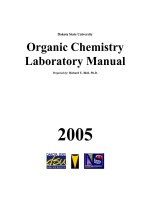organic chemistry
Bạn đang xem bản rút gọn của tài liệu. Xem và tải ngay bản đầy đủ của tài liệu tại đây (712.53 KB, 87 trang )
Organic Chemistry
Organic Chemistry- The study
of carbon & carbon compounds
•
Organic compounds are the primary constituents of all living
organisms.
Draw an electron dot diagram of carbon.
Χ●
●
Χ
C
●
Χ
Χ●
Carbon is able to form 4 covalent
bonds (4 valence electrons) with
other carbon or other elements.
II. Characteristics of Organic
Compounds
They are nonpolar compounds – they do not dissolve in polar solvents
like
Water.
O H +
+
H
•
*remember the rule –
“likes dissolve likes”
4) They have low melting points – due to weak intermolecular forces.
C-C
● ● ● C-C
5) They react slower than ionic compounds – due to strong covalent
STRONG
STRONG
bonds between atoms.
weak
Structural Formulas –
A 2D model shows bonding patterns and
shapes of molecules
H
Carbon is found in the center
H
The short line – represents a
pair of electrons.
C
H
H
Draw the structures for each
organic
H
1. Methane: CH4
H
2.
Chloroform
Cl
3. Ethane: C2 H6
Remember : Carbon
has 4 bonding sites.
C
H
H
H
: CHCl3
C
Cl
Cl
H
H
H
C
C
H
H
H
Types Of Bonds
Single Bond – single covalent bond in
which they share 1 pair of electrons. (2 e-)
●
C C
●
C
●
●
● ●
C
●
●
Double Bond – carbon atoms may
share 2 pairs of electrons to form a
double bond.
C C
●
C
●
●●
●●
●
C●
Triple Bond – carbon atoms may share
3 pairs of electrons to form a triple bond.
C
C
●C
●●
●●
●●
C●
Types Of Compounds
Saturated Compound – organic compounds in which carbon atoms are
bonded by SINGLE bonds.
ex. Methane: CH4
H
H
C
H
H
Types Of Compounds
Unsaturated Compound – compounds
where carbon atoms have double or
triple bonds.
ex. ethene: C2H4
H
H
H
C C
H
Homologous Series of Hydrocarbons
•
Organic compounds can be classified into groups with related
structures and properties.
***As size of molecule increases the
boiling and freezing points increase.
Hydrocarbons are organic compounds
that consist of only Carbon and
Hydrogen atoms.
H
H
C
H
H
H
H
H
C C
H H
H
< TARGET="display">
single
●
Saturated hydrocarbons
Alkanes = CnH2n+2
• A saturated hydrocarbon contains 5
carbons. What is the formula?
C5H2(5)+2 = C5H12
•
A saturated hydrocarbon contains 20 carbons. What is the formula?
C20H2(20)+2 =
C20H42
Saturated = Single
Alkanes
•
CH4 = methane
•
C2H6 = ethane
•
C3H8 = propane
•
C4H10 = butane
•
C5H12 = pentane
The smaller the compound the Lower Boiling
point and Melting point is (less bonds to break)
< TARGET="display">
Naming Organic Compounds
•
Organic compounds are named according to the IUPAC (international union of pure & applied chemistry) system of nomenclature.
Alkanes – end in
Alkenes – end in
Alkynes – end in
ane
ene
yne
Alkenes – CnH2n
•
•
series of unsaturated hydrocarbons
having one double bond (C=C)
Also called ethylene series (IUPAC name
is ethene)
General formula CnH2n
Alkenes
•
•
•
•
•
C2H4 = Ethene
C3H6 = Propene
C4H8 = Butene
C5H10 = Pentene
To find the number of hydrogens, double
the number of carbons.
1-Butene
This is 1-butene, because the double
bond is between the 1st and 2nd carbon
from the end.
ISOMERS: Molecules have the same
molecular formula, but have different
structural formulas.
Pentene
This is 1-pentene. The double bond is
on the first carbon from the end.
This is not another isomer of pentene.
This is also 2-pentene, just that the
double bond is closer to the right end.
Alkynes –
a series of unsaturated
hydrocarbons that contain 1 triple
bond.
•
Also called the acetylene series
General formula CnH2n-2
C
C
